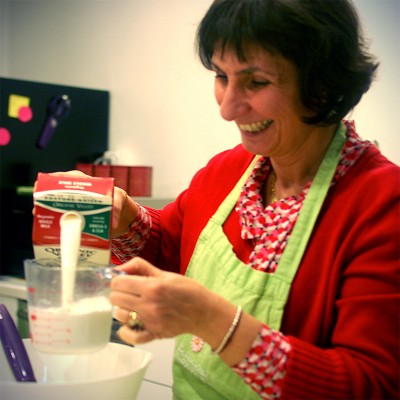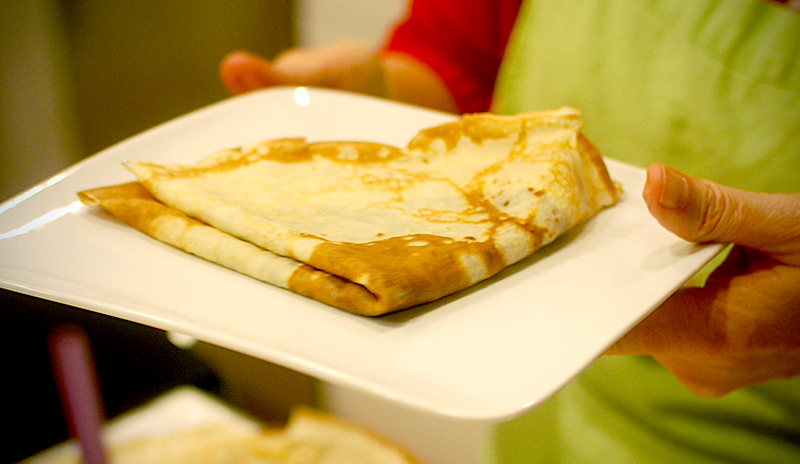Today is the world’s sweetest holiday, the Chandeleur. Celebrate as the French do by cooking up a mountain of fluffy (yet paper-thin!) crêpes.
In France, most holidays are paired with some special kind of food, and every celebration is an opportunity for some delicious treats – Bûche de Noël for Christmas, Galette des Rois for the Epiphany.
The Chandeleur (Candlemas) is no exception. As long as I can remember, my family has always celebrated the Chandeleur by making enormous quantities of crêpes and inviting neighbors and friends for crêpes orgies.
It is celebrated the second day of February when Jesus was presented at the Temple of Jerusalem and marks the start of the Carnival period which ends on Fat Tuesday.
It has since become a tradition to light candles…and eat loads of crêpes.
Why this celebration has become a French national crêpe day is more of a mystery. Some speculate that it’s because the Romans would eat pancakes during the Lupercalia, their round shape and golden color supposedly a reminder of the sun coming back after a long winter.
The Chandeleur is more widely believed to bring happiness and prosperity to your home. How?
Easy: Just hold a gold coin in your left hand and a crêpe pan in the other. Then, flip the crêpe in the air and try to catch it in the pan.
If you succeed, tradition says, you’ll be thriving for the rest of the year. If not, you just made a mess on the floor and your dog will be thankful.
Learning the proper way to make crêpes with Muriel Foucher from Paris Eastside

There is nothing easier than preparing a crêpe batter, but obtaining the right texture is another matter.
And no, it is not just a thin pancake. Crêpes should be light and paper-thin while staying soft and fluffy — a delicate equilibrium based on a couple of tricks that Muriel Foucher from Paris Eastside offered to share with us.
Muriel ran a cooking school in Paris. When her husband was relocated to Seattle four years ago, she decided to pursue her passion here on the West Coast, by opening a store-slash-cooking-school in the heart of Capitol Hill.
Why name her company Paris Eastside, then? It’s a nod to her personal trajectory: from Paris to the eastside of Seattle, where she currently lives.
The store offers lots of authentic French products, though they might seem non-traditional in the eyes of anyone not French.
No Eiffel Tower gifts, mustard or camembert; rather, chestnut spread, fraises tagada and carambar (two very popular candies in France) and crozets (delicious little pasta from Savoy). A very eclectic and personal selection.
To make the crêpes, you will need the basic ingredients, patience, some knack (It’s all in the wrist!) and a pan. Muriel will tell you that nothing makes better perfectly shaped crêpes than a real crêpes pan, but your usual frying pan will work too.
Ingredients:
18 ounces of flour (no cups in French cooking, except for liquids, we weigh the ingredients)
4 tbsp. sugar
A pinch of salt
6 eggs
6 cups whole milk
4 tbsp. butter, melted
Combine the flour, sugar and salt in a large mixing bowl. In another bowl, beat the eggs, add the milk and stir in melted butter. Mix well and gradually add to the dry ingredients. Mix until the batter is smooth.
That’s where it becomes difficult: you have to place the batter in the fridge for two hours. As a kid, I remember the waiting was torture, but now I can see the advantage. The rest period helps the gluten to relax and ensures that the texture of your crêpes will be tender instead of chewy.
But if you’re impatient or in a rush, just skip that step, and it will work just fine.
Before you start cooking, whisk the batter once again, using a blender if it’s lumpy. If the texture seems too thick, just add a little bit of milk to thin it.
Fire up your stove and lightly grease your pan. Pour a little less than a full ladle of batter for each crêpe, tip and rotate the pan to spread the batter as thinly and evenly as possible.
When the sides of the crêpe start to dry and curl, flip it over and let cook on the other side for about 40 seconds to a minute. Adjust the heat if it’s too hot and the crêpes are starting to burn.
Muriel served those crêpes with a delicious chocolate ganache, but if you want to experience the real Parisian deal, sprinkle sugar on top of your crêpe and squeeze some lemon juice to add a little zing to it.
Enjoy it as the French do with a glass of hard cider.

If you’re having trouble flipping the crêpes, Muriel shared a secret trick that proved to be helpful during our session.
When the bottom of your crêpe is golden and most of the bubbles have burst, use a spatula to lift it off the pan, flip it over and place it back down on the pan. Once both sides are cooked, take a chance and launch it in the air.
It’s much easier that way. Who said it was cheating? Don’t worry if it doesn’t work right away. The first crêpes are usually sacrificial, the pan being too cold or the batter too thick.
I was a bit surprised to learn that Muriel is also the author of a cookbook on microwave cooking, Easy French Microwave Recipes. (I know people tend to put French cuisine on a pedestal, but — no offense, Julia Child — hardly anyone can pull off a boeuf bourguignon, an onion soup or a cheese soufflé on a regular basis.)

Muriel explained that she had always limited her use of that common kitchen appliance to melting butter or reheating dishes but had never considered further uses until her son, away at college, started to complain about the quality of the food served at his university’s cafeteria.
So she tried to come up with easy but tasty recipes using only the microwave. More than a rehabilitation of the microwave, it is also an interesting way to democratize French cuisine.
If you’re interested in mastering the French art of crêpe making, Muriel is having another crêpes making class on March 9.
Paris Eastside offers a range of activities from the classic French cuisine 101 to wine and food pairing classes. Check out the calendar.



The crepes sound wonderful. I can’t wait to try to make them. And Muriel’s
“Easy Quick Microwave Recipes,” is intriguing too, for those of us who want in and out of the kitchen fast without compromising good taste.